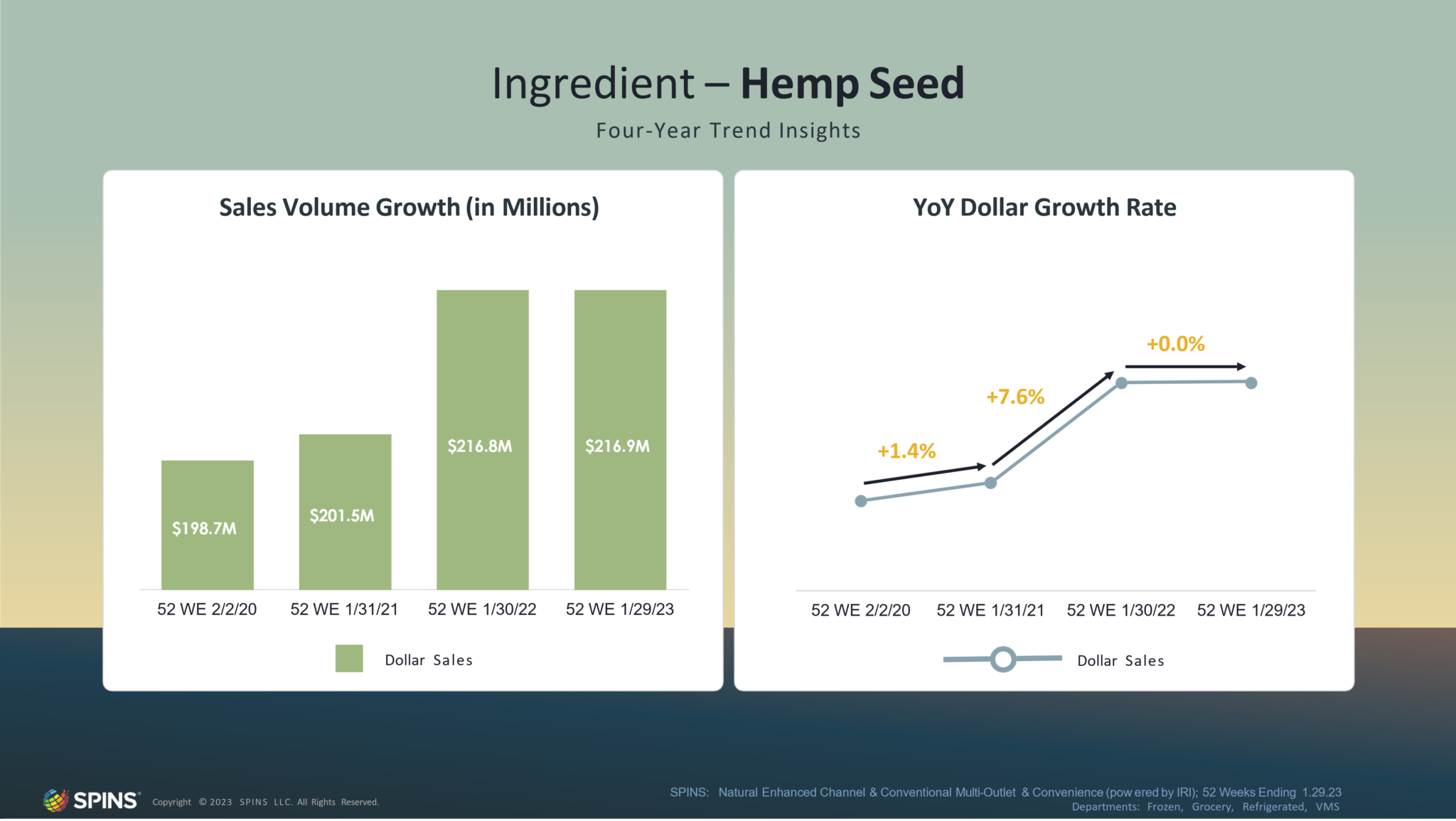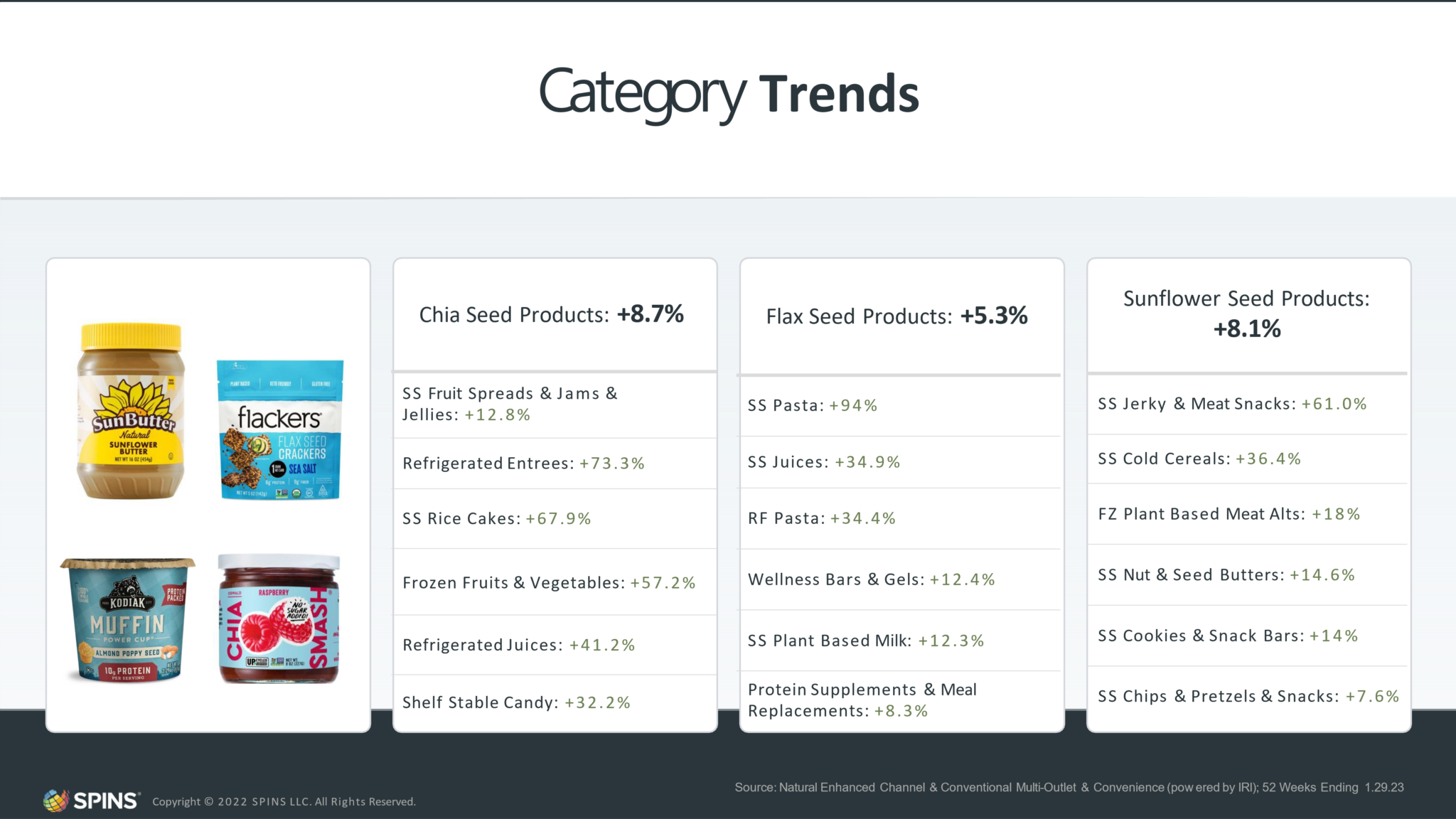Key Takeaways:
- Hemp seeds have the potential to expand their market share in the seed market
- Hemp seeds are being used as ingredients to enhance their nutritional profiles and sustainability missions.
- Functional beverages are a key driver of hemp seed usage in food and beverage products.
- Consumers are seeking innovative ways to add nutrients to their diets in the plant-forward space.
Hemp, a versatile and sustainable plant, has been gaining popularity in various industries, including food and beverage. Here’s a deep dive into the current market for hemp and its potential applications in different product categories.
Hemp in the Seed Market
When looking at the seed market, hemp currently lags behind other super seeds such as chia and flax in terms of sales. Hemp seeds saw a 7.6% increase in year-over-year sales 2 year ago but this past year, sales have remained flat. However, with its favourable nutrition profile, we see significant potential for hemp to expand its market share, like the booms witnessed in flax and chia seeds.

Hemp as an Ingredient in Various Products
In addition to being sold as standalone seeds, hemp seeds are also being used as ingredients in a wide range of products. Categories such as creams and creamers, hot cereals, candy, frozen entrees, and functional beverages are incorporating hemp seeds to enhance their nutritional profiles and sustainability missions. Creams and Creamers containing hemp seeds have seen a 129.6% increase in year-over-year sales while Hot Cereals containing hemp seeds have seen a 48.3% increase. Hemp seeds are particularly popular in plant-based products, as they are THC-free and can add protein and fiber content to various food and beverage offerings.

Hemp in Functional Beverages
Functional beverages been a key driver of hemp seed usage in food and beverage products. Hemp seeds, which were initially popular in the supplement channel, are now making their way into functional beverages. This trend aligns with the trajectory of other super seeds like chia, flax, and sunflower seeds, which have found success in expanding beyond their original categories and into innovative new product offerings.
Reimagining Growth: Super-seeds
Consumers are increasingly seeking innovative ways to add nutrients to their diets, particularly in the plant-forward space. Looking to some of the more mature super-seeds, including chia, flax and sunflower seed, are gaining popularity as consumers crave new ways to improve their nutrition. Categories such as pasta, wellness bars, jams and jellies, and frozen fruits and vegetables are also exploring the incorporation of hemp seeds to meet consumer demands for functional and sustainable products. Looking at what categories these super-seeds are seeing growth, may be of some inspiration to those in the hemp seed space

Consumers are increasingly seeking innovative ways to add nutrients to their diets, particularly in the plant-forward space.
What’s Next For Hemp?
In conclusion, the market potential of hemp is significant, with opportunities for growth in both the seed market and as an ingredient in various food and beverage products. As consumers continue to prioritize nutrition, sustainability, and innovation, hemp seeds offer a promising option for meeting these demands. With its favourable nutrition profile, THC-free status, and versatility, hemp has the potential to continue its expansion in the market, offering exciting opportunities for the food and beverage industry to explore.
How can Brands use this data?
CPG brands can use information like this and other data from SPINS to stay ahead of the curve and meet evolving consumer demands for plant-based, nutrient-rich, and sustainable products such as:
- Incorporating hemp seeds in their products. By doing so, they can tap into the growing demand.
- Differentiating their products to appeal to consumers who are looking for innovative ways to add to or change their diets.
- Explore new categories. By incorporating hemp seeds they can offer new and innovative products to add to a retailers mix.
- Leveraging SPINS data. Insights like these help brands identify growth opportunities, track category performance, and optimize product offerings.
How can Retailers use this data?
Retailers can use the information to make informed decisions about their product offerings, marketing strategies, and category management. Here are a few ways they can use this information:
- Identify growth opportunities. Retailers can use SPINS data to identify growth opportunities in the hemp seed market and adjust their product offerings accordingly. By stocking popular hemp seed products and exploring new product categories, retailers can tap into the growing demand for plant-based, nutrient-rich, and sustainable products.
- Cater to consumer preferences. Retailers can use the information to cater to consumer preferences by offering a variety of hemp seed products that meet different needs and tastes.
- Highlight sustainability. By doing so, they can differentiate themselves from competitors and appeal to consumers who prioritize sustainability.
- Optimize category management. By tracking category performance, identifying trends, and adjusting their product offerings they can stay ahead of the curve and meet evolving consumer demands for plant-based, nutrient-rich, and sustainable products.








